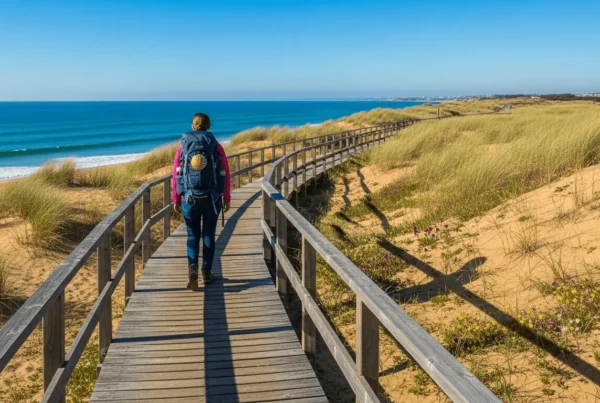Completing the Portuguese Coastal Way: From Padrón to Santiago
Stage 11 of the Portuguese Coastal Way leads pilgrims through 24 kilometers of varied Galician terrain, culminating in the sacred city of Santiago de Compostela. This stretch of the Portuguese Camino is often described as the most emotionally charged. The journey begins in the quiet charm of Padrón and ends at the grand cathedral where Saint James rests, marking the culmination of days, sometimes weeks, of reflection and effort.
From wooded trails to the urban pulse of Santiago, every step carries meaning. This is a stage of both anticipation and closure, ideal for pilgrims walking with a sense of purpose.
Final Stage Overview
- Distance: 24 kilometers / 15 miles
- Estimated Time: 5 to 6 hours
- Difficulty: Moderate
- Landscape: Villages, forests, rolling countryside, and urban settings
- Key Points: A Escravitude, Milladoiro, Santiago de Compostela
- Must-Bring Items: Pilgrim credential, camera, comfortable walking clothes
Completing the Portuguese Coastal Way: From Padrón to Santiago
Stage 11 of the Portuguese Coastal Way leads pilgrims through 24 kilometers of varied Galician terrain, culminating in the sacred city of Santiago de Compostela. This stretch of the Portuguese Camino is often described as the most emotionally charged. The journey begins in the quiet charm of Padrón and ends at the grand cathedral where Saint James rests, marking the culmination of days, sometimes weeks, of reflection and effort.
From wooded trails to the urban pulse of Santiago, every step carries meaning. This is a stage of both anticipation and closure, ideal for pilgrims walking with a sense of purpose.
Following the Route from Padrón to Santiago Compostela
Morning Departure from Padrón
Start your day early from Padrón, a place historically connected to the arrival of Saint James’ remains. The first kilometers offer a peaceful introduction, with forested paths and soft hills easing you into your final day.
A Escravitude: A Spiritual Pause
One of the most notable stops is A Escravitude, home to the Sanctuary of Our Lady of A Escravitude. This serene baroque church has long been a destination for local pilgrims. Its surrounding gardens provide a quiet moment for reflection.
Through the Villages to Milladoiro
The path continues through small villages and rural lanes. Eventually, you reach Milladoiro, a key milestone on the route. Here, many pilgrims catch their first glimpse of Santiago’s cathedral towers—a powerful moment that symbolizes the nearness of your goal.
Entering Santiago de Compostela
As you walk into Santiago, the scenery shifts. Cobblestone streets, rising buildings, and an air of anticipation welcome you. The route weaves through the city until you reach Praza do Obradoiro, where the Cathedral of Santiago rises in grandeur.
Unmissable Places and Experiences
The Cathedral of Santiago
A masterpiece of Romanesque and Baroque architecture, the Cathedral of Santiago is the final resting place of Saint James the Apostle. Step inside to witness centuries of history and devotion. Don’t miss the Botafumeiro, the giant incense burner swung during certain pilgrim masses.
The Pilgrim’s Office
Present your pilgrim credential at the Oficina del Peregrino to receive your official Compostela certificate. The office is well-marked and located near the cathedral. It’s wise to arrive early, especially during peak season.
San Martiño Pinario Monastery
Just steps from the main square, this monastery is the second-largest religious complex in Spain. Its imposing façade and quiet courtyards make it a worthwhile visit after completing your pilgrimage.
Where to Stay and What to Eat in Santiago
Accommodation in Santiago de Compostela
- Albergue Seminario Menor: A popular choice for pilgrims looking for affordability and a communal atmosphere.
- Parador de Santiago – Hostal dos Reis Católicos: A luxury hotel located right beside the cathedral, steeped in history and elegance.
Recommended Dining Options
- Casa Manolo: Loved by pilgrims for its generous portions and traditional Galician cuisine.
- O Curro da Parra: Offers refined local dishes prepared with fresh seasonal ingredients.
For more recommendations, check out our article on Post-Camino recovery and local gastronomy.
Essentials for Your Final Stage
- Pilgrim Credential: Ensure you have all required stamps from each stage.
- Camera or Smartphone: To capture moments at the cathedral and surrounding city.
- Comfortable Walking Clothes: Dress in layers suitable for urban walking and emotional celebration.
FAQ: Your Final Questions Answered
Is the terrain difficult on this stage?
The final stretch is moderate with gentle ascents. The emotional weight can be significant, but physically it is manageable for most pilgrims.
What’s the best time to arrive at the cathedral?
Late morning or early afternoon offers good light for photos and allows time to visit the Pilgrim’s Office before it gets crowded.
Can I attend a pilgrim mass?
Yes. Pilgrim masses are held daily at the cathedral. Arriving at least 30 minutes early is recommended for good seating.
Where do I collect the Compostela certificate?
At the Oficina del Peregrino, which is clearly signposted and a short walk from Praza do Obradoiro.
Reflections: The Portuguese Camino Transforms You
More than a destination, Santiago de Compostela represents the spiritual and personal growth experienced along the Portuguese Coastal Way. This last day often brings tears, laughter, and profound gratitude. Whether you walked for faith, healing, or personal challenge, you’ll arrive changed.
Many pilgrims choose to linger in the city, revisiting the cathedral, reconnecting with fellow travelers, or simply sitting in silence in the plaza. These are the moments when the meaning of the Camino truly settles in.
To continue processing your journey, see our guide on Camino reflections and integrating lessons into daily life.
Share and Stay Connected
Join our Pilgrims of the Coast WhatsApp community to share your story and hear from others. Your insights can inspire future pilgrims and help preserve the living spirit of the Camino.
And if you’re considering a future route, don’t miss our upcoming guides on the Camino Inglés and other alternative paths.






